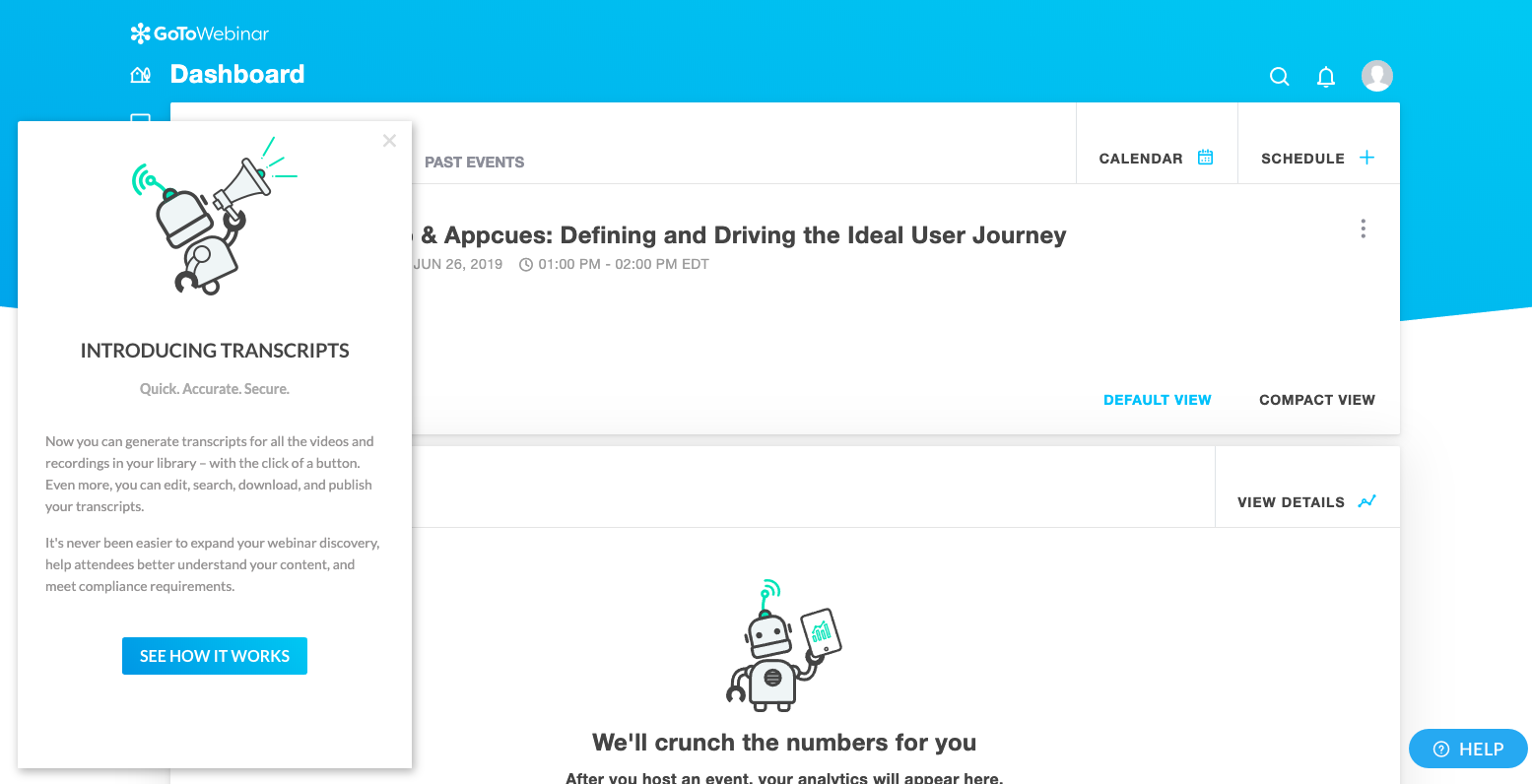Feature Adoption Guide: What Is It & How to Improve It

.png)

.png)
Products are nothing without their features. An iPhone without apps is...well, it’s still technically a phone, but that’s it. Features give products value, and that value keeps customers happy and coming back for more.
But customers can’t use features if they don’t know they exist. Users don’t magically understand what they can do with your app—you have to show them the way. Even then, customers don’t value features just because they’re there. Your product could have a gajillion features and still miss the mark with your target users.

High feature adoption rates are critical to the overall health of your product. Users who find and make a habit out of using your product’s features have a better shot at sticking around long term. On the flip side, users who don’t use your features won’t understand the value of your product and are more likely to churn. You built your product for growth—but you won’t get there unless you focus on measuring and improving your feature adoption rates.
Feature adoption occurs when a user is introduced to a product feature and decides to use it. A good feature adoption rate indicates users are aware that a feature exists, understand its value, and feel compelled to use it regularly. A poor rate is usually a sign that you’ve got problems with feature awareness—and you might not be doing a great job communicating the value of your product to customers.
It’s helpful to think about feature adoption in buckets. Companies can dive into their product data to identify whether their feature adoption rate is exceptional, subpar, or somewhere in between. Looking at this data will help determine what percentage of a product’s total user base engages with a particular feature—a measurement called the feature adoption rate.
Calculate your feature adoption rate using this formula:
feature adoption rate (%) = (# of new users of a specific feature/total # of product users) x 100

A user who subscribes to a product but doesn’t use any of its features won’t keep paying for it. Even companies with terrific sales rates can’t grow with a dismal churn rate. So if you want to grow your product, then you gotta maintain healthy feature adoption rates.
When you design a new feature, it’s purpose-built with intention. Maybe you’ve designed your next feature to offer a new solution that no other product offers. Perhaps your newest one aims to improve your user onboarding process. When users don’t adopt these features, the objectives they were built to satisfy go unachieved, impacting everything from your UX to your revenue stream. TL;DR: user adoption tracking and feature adoption are both important.
Unlike feature adoption rates, a product adoption rate gives a holistic view of overall usage. Think of your product as its own company. You can measure the overall health of the company based on yearly revenue, but that doesn’t say much about the individual performance of each department. Similarly, your product adoption rate gives a high-level sense of how your product performs, but feature adoption rates calculate how its individual components fare with users.
You have one product adoption rate because your product is a singular entity. However, you can measure the adoption of multiple features within your product to calculate the different adoption rates for each feature. While feature adoption rates are handy for identifying how many users actually use a specific feature, your product is the sum of every feature.
The formula for calculating a product adoption rate looks remarkably similar to that of feature adoption. The key difference lies in the fact that it considers the entire user base instead of users of a specific feature:
product adoption rate (%) = (# of new users/total # of product users) x 100

Users stick around past the first login when they are engaged and find value in your product. The more features people use, the more value they get from the product. Customers who feel like they aren’t getting their money’s worth find themselves on the fast track to Churn City. You need to keep an eye on how every one of your product’s features performs to retain users.
Subscription-based services are the norm in the SaaS world. This makes tracking feature adoption especially crucial. Every time a company sends over monthly bills to subscribers, those subscribers consider whether that product still benefits them. This setup puts pressure on SaaS businesses to regularly show how their product meets users’ needs and adds value.
Feature adoption tracking empowers you to improve your product at specific touchpoints. You can investigate what makes certain features sticky once you figure out which features people use frequently. Then use those insights to make other features even more attractive.
Diligent tracking also shines a spotlight on unpopular features—nudging you to dive into your product analytics to understand why features are being ignored. You can head back to the drawing board equipped with information about your less-utilized features to determine what to improve, rebuild, or toss.
True performance tracking requires more than just looking at a formula. You also need to assess the entire feature adoption funnel. Analytics specialist and founder of ProjectBI Justin Butlion developed a four-step framework to provide a more nuanced understanding of feature adoption. In Butlion’s own words, it’s “a high-level way to understand the most basic usage metrics of [a product’s] features.”
The four parts of the funnel are:

Imagine you’re launching a feature called “CueIt” that lets users share data from your product with their social media channels. The journey through CueIt’s feature adoption funnel might look something like this:
You can’t expect anyone to use new CueIt features when they don’t know they exist. Most humans won’t hunt for new features. You need to alert users about these additions if you want them to discover and use new parts of your product.Exposure is measured as the percentage of users who landed on a feature’s screen (on mobile apps) or page (on a website). The user doesn’t need to take action at this point, as exposure simply calculates how many people know the feature exists at all. If 1,000 people used your product, and 450 of those people saw the CueIt page or screen, your exposure rate is 45%.

A low exposure rate could be the culprit in the event of a low feature adoption rate. In that case, figure out ways to increase feature discoverability and raise the likelihood of feature adoption.
You know that 450 users are aware of CueIt’s existence. Now, you need to find out what percentage of them took action and activated the feature after exposure. Imagine 300 of the users connect CueIt to at least one of their social media accounts. That’s a 67% activation rate.

At this step in the funnel, it helps to consider two points:
The answers to these questions can provide insight into how well your feature’s screens or pages effectively sell users on its benefits.
Keep in mind that you can enable and disable features. This means the number of users who currently have the feature enabled won’t match the number of people who activated it since its launch. Use event-based tracking to keep a historical record of activation and learn when users first activated the feature.
The “used” step of the feature adoption funnel shows you how engaged users are with the feature after activating it. If folks aren’t moving from activation to usage, you need to put more effort into highlighting the feature’s benefits. It’s not enough just to tell users a feature exists. You also need to sell them on the value the feature provides to regular users.
Activation and usage are one and the same in some features, such as filling out a profile. In CueIt’s case, usage is distinct. People must take the step of actually sharing information on social media after they’ve enabled the feature.
Although a large percentage of users activated CueIt, only 50 of those people used it. That means only 16% of activated users went on to use the feature.

The final step of the funnel shows you just how sticky your new product feature is. Is it a one-hit-wonder, or do people use it repeatedly?
Pretend 45 of the 50 feature users continue their journey after the initial use for a 90% “used again” rate. (Looks like users who get on the CueIt train aren’t rushing to hop off—and they’re definitely not headed for Churn City.)

Assess your product data to make sure customers consistently use each feature. But remember, not every feature requires repeat use, so this part of the funnel may not always apply.
This funnel framework highlights how important it is to break feature adoption down into discrete stages. If you only calculate how many of the product’s total users engaged with CueIt once, the feature adoption rate clocks in at 30%. The overall feature adoption rate doesn’t give us a thorough enough look into which parts of the adoption funnel to improve. So while your general feature adoption rate is a good starting point, a deeper funnel analysis provides more actionable insights.
Simply knowing you have room for improvement doesn’t magically make your product perform better. Use these tips to improve your current feature adoption rates:
The journey toward getting users to adopt new features starts with feature discovery. Put your features front and center for all to see to help users overcome feature blindness.
Ideas for how you can get your features in front of users include:
And just because users are exposed to a feature and don’t activate it right away doesn’t mean they won’t ever use it. Sometimes, users love an old feature but forget about it. That’s why announcements are so powerful since they can encourage users to revisit forgotten features.
Find opportunities to re-introduce ignored features to existing users. Continue educating users on relevant features with well-placed in-app prompts. For instance, tooltips are great for resurfacing features to existing users.
Read more: 9 top-notch examples of feature tours and prompts that improve adoption

Your customers provide a more unbiased view of a feature and its value. Conduct user tests before launching a new feature to get a feel for how the feature works for your customers. Users might find some kinks in the user experience (UX) for you to work out before you release the feature into the wild.
Analyze cohorts once you feel like the feature is ready to go, and conduct user surveys to discover how a wider audience feels about it. This customer feedback helps you gauge how customers feel about the UX and what specific benefits users find in the feature. User surveys are also a great way to find out if your customers turn to a competitor’s product to address the pain point your feature is meant to solve.
Read more:6 outstanding examples of in-app user surveys, customer feedback forms, and NPS.
It’s worth using every method at your disposal to reduce churn and increase engagement. Luckily, many tools exist that increase awareness of your features while highlighting their value, including:
Users don’t have premonitions in the night that alert them to the release of your next great feature. You need to get the word out ahead of its release to build anticipation among your user base. A multi-channel approach maximizes the exposure of your message to an audience that includes both existing users and prospects who are enticed by the potential of your new offering. Potential channels include:

UI/UX patterns remain the most direct way to alert users to a newly released feature. In-app messages reach a user while they’re already using your product. Carefully designed in-app messages announce and even guide users to new features. Create messages about more niche features with opt-out options to avoid frustrating users. Alternatively, require users to take short-and-sweet tutorials for high-value features.
Different formats for in-app messaging include:
Appcues allows you to build pleasing in-app messages without the hassle of coding. It also includes a robust analytics platform to help you track events and measure your feature adoption rate. Its ability to both measure and improve feature adoption rates makes it the perfect solution for your adoption improvement goals.
Read more: Boost feature adoption rates with seamless in-app messages from Appcues
Release notes might not seem as splashy as other hype-building feature announcement tools, but they serve a critical function in the overall feature adoption effort. Release notes report the changes made to a product with each new iteration, including any new features included in the newest update. Good release notes balance explaining the more technical aspects of a new software version with emphasizing the value of these improvements.
These notes serve as a more formal record of the changes made to a product over time. Users can scroll through the entire history of changes and feature releases that occurred over a product’s life cycle. Release notes offer the most comprehensive information to users interested in diving deep into the evolution of a product or pinpointing when a product introduced a specific feature.
Read more: How to write release notes (+5 great examples)
Microsoft maintains a record of its release notes for Outlook on a dedicated landing page. This method eliminates the need for users to dig through the App Store/Google Play Store or the product itself to find the technical details of a release. It also prevents them from bogging down a user with messages of considerable length and complexity while they’re using the app.

Just because a feature has a great adoption rate now doesn’t mean it’ll stay that way forever. The needs of users shift and change, which means the way they interact with your product will too. Additionally, every change you make to improve the adoption rate of one feature can impact the adoption rate of other features in unforeseen ways.
Your feature adoption rate will constantly change, so it’s important to regularly monitor it. Remember: your feature adoption rate only gives a limited view into how your entire product is performing. Check on a feature’s performance at every stage of the funnel to create an impactful product experience. Use that information to pivot if adoption is decreasing, or stick with what’s working if users just can’t get enough.